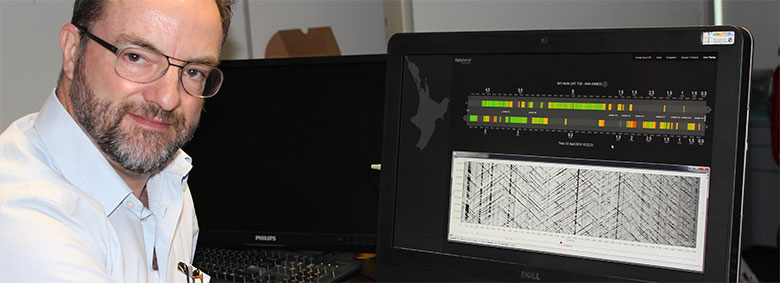A new and innovative way of gathering raw data about traffic flows is being introduced to the NZ Transport Agency’s Northern Gateway toll road, north of Auckland.

Russell Pinchen with the traffic data display at Auckland’s JTOC.
A hi-tech system is now in use that can ‘hear’ traffic on motorway lanes to provide up to the minute traffic information. It uses an existing fibre optic cable (FOC) that runs 38 kilometres alongside the motorway to gather sound frequencies from vehicles and converts these to useable data. This information is then interpreted and visually displayed to traffic engineers managing traffic flows and safety systems on the busy highway.
The fibre optic cable was laid on one side of the motorway when it was built, and is used to provide information and data from the Johnstone’s Hill tunnels and toll road to the Agency’s control centre at Smales Farm, Takapuna.
But now a new way of taking acoustic signals from the cable and converting them to useable data has been developed – which can mean substantial savings for traffic management and operations.
The data that’s fed from the FOC augments information available to operators from highway cameras, police, and road users, and provides important information in real time on traffic congestion, vehicle flows, and even the type of vehicles traversing a given piece of highway.
The technology that drives the system (DAS – distributed acoustic sensing) has been used extensively in industrial applications around the world, but has only recently been applied to the gathering of data for traffic safety and highway management. It’s been trialled in Wales, but this is the first time it’s been applied to traffic management elsewhere.
Engineers with the NZ Transport Agency, who recognised the potential, look to major cost savings and greater efficiencies in future, as the physical equipment required is far less than that needed with existing data gathering systems. Currently, the sensors that detect vehicle movements and provide data or activate traffic signals consist of wire loops embedded in the carriageway. Further, an associated signal box has to be placed every 500 metres along a motorway or at each intersection on urban roads.
But FOC gathers sound frequencies at every point along its length, and this information can be pinpointed to provide essential information to traffic managers. Although the software and data management “black boxes” at the terminals of the cable are complex, the fibre optic cable near or in the highway carriageway itself is the only piece of equipment required.
In future and for new highway projects, the cable is easily laid in the tarmac and needs little or no maintenance.